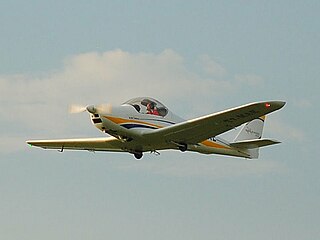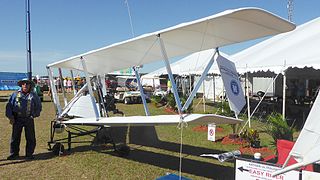See also
Aircraft of comparable role, configuration, and era
| Solar One | |
|---|---|
| Role | Electric aircraft |
| National origin | United Kingdom |
| Manufacturer | Solar-Powered Aircraft Developments |
| Designer | David Williams |
| First flight | 13 June 1979 |
| Introduction | 1978 |
| Retired | 1979 |
| Number built | One |
The Solar-Powered Aircraft Developments Solar One is a British mid-wing, experimental, manned solar-powered aircraft that was designed by David Williams and produced by Solar-Powered Aircraft Developments under the direction of Freddie To. On 13 June 1979 it became one of the first solar-powered aircraft to fly, after the unmanned AstroFlight Sunrise and the manned Mauro Solar Riser, and the first successful British solar-powered aircraft. [1] [2] [3]
Freddie To was a member of the Kremer prize committee who started his own project to produce a human-powered aircraft to compete for the prize. Its structure comprised a wooden frame covered with heat-shrunk Solarfilm model aircraft film. The wing was built in three sections, a centre section and two outer wing panels to simplify storage and transport. The wing spar is a laminated spruce girder box-spar design. The tail surfaces are quickly removable for storage. [1] The resulting aircraft, at 230 lb (104 kg), proved too heavy for human-powered flight and so To converted it to solar power.
A nose-mounted pod powerplant was installed consisting of four 1 hp (1 kW) permanent magnet 36 V DC, 12 A Bosch electric motors, powered by a 65 lb (29 kg) Nickel-cadmium battery pack of 24 cells with a total capacity of 25 AH, connected in series to give a maximum (open-circuit) output voltage of approximately 29 V. The motors drive a 63 in (160 cm) two-bladed propeller via a 3:1 bicycle-chain reduction gear. The propeller turns at a maximum of 1,100 rpm, decreasing with battery discharge. Power is controlled with a simple on/off switch.
To recharge the batteries, 750 solar cells of 3 inch diameter were installed at a cost of £6,000. At that time solar cells were very expensive. They were the most costly part of the aircraft and had to be limited in capacity to remain within the project budget of £16,000. [1] [2]
The output from the solar cells is not sufficient to sustain flight. Before flight they are used to charge the batteries. The batteries then provide power for takeoff and initial climb. The installed batteries provide for a climb of eight minutes plus a two-minute cruise allowance. [1]
The first flight attempt took place at Lasham Airfield, Hampshire, United Kingdom on 19 December 1978. The propeller pitch was incorrectly set and the attempt achieved only a short hop. At the hands of pilot Ken Stewart, a successful flight took place on 13 June 1979, covering just under 0.75 mi (1.2 km). [1] The aircraft lifted off at 18 to 20 kn (33 to 37 km/h) and reached 35 kn (65 km/h) and 80 ft (24 m) in height. A second flight on the same day by Bill Maidment achieved a speed of 42 kn (78 km/h). All flights were made on battery power that had been supplied on the ground from the installed solar cells. [1] [2]
A planned flight across the English Channel was abandoned when it was found that the aircraft did not meet its endurance targets. [2]
Data from History of Solar Flight [2] and Flight Global [1]
General characteristics
Performance
Aircraft of comparable role, configuration, and era

The Kappa 77 KP-2U Sova, later produced as the Jihlavan KP-2U Skyleader and most recently as the Jihlavan Skyleader, is a two-seat civil utility aircraft designed in the Czech Republic and available in kit form for home building. It is a conventional low-wing monoplane featuring all-metal construction and tricycle undercarriage.

An electric aircraft is an aircraft powered by electricity, almost always via one or more electric motors which drive propellers. Electricity may be supplied by a variety of methods, the most common being batteries. Electrically powered model aircraft have been flown at least since the 1970s and were the forerunners of the small unmanned aerial vehicles (UAV) or drones, which in the twenty-first century have become widely used for many purposes.

The Solar Challenger was a solar-powered electric aircraft designed by Paul MacCready's AeroVironment. The aircraft was designed as an improvement on the Gossamer Penguin, which in turn was a solar-powered variant of the human-powered Gossamer Albatross. It was powered entirely by the photovoltaic cells on its wing and stabilizer, without even reserve batteries, and was the first such craft capable of long-distance flight. In 1981, it successfully completed a 163-mile (262 km) demonstration flight from France to England.

The Gossamer Penguin was a solar-powered experimental aircraft created by Paul MacCready's AeroVironment. MacCready, whose Gossamer Condor had made the first human-powered flight in 1977, told reporters two weeks in June, 1980 that "The first solar-powered flight ever made took place on May 18." The testing ground was at Minter Field outside of Shafter, California.
The AstroFlight Sunrise was an uncrewed experimental electric aircraft technology demonstrator and the first aircraft to fly on solar power.

The Pipistrel Taurus is a Slovenian self-launched two-seat microlight glider designed and built by Pipistrel.

The Mauro Solar Riser is an American biplane ultralight electric aircraft that was the first crewed aircraft to fly on solar power. It was also only the second solar-powered aircraft to fly, after the uncrewed AstroFlight Sunrise, which had first flown 4+1⁄2 years earlier.

The UFM Easy Riser is an American swept wing biplane hang glider that was first powered in 1975, becoming the first modern ultralight aircraft. The Easy Riser was still in production as an unpowered glider in 2002 by Ultralight Flying Machines.

The e-Genius is a crewed electric airplane, which was developed by the Institute of Aircraft Design at the University of Stuttgart and first flew in May 2011.

The Alisport Silent 2 Electro is an Italian mid-wing, single-seat motor glider, designed and produced by Alisport of Cremella and provided as a complete ready-to-fly aircraft. The aircraft was introduced at the Aero show held in Friedrichshafen in 2011.

The Yuneec EViva is a Chinese low-wing, two-seat motor glider that was designed by Martin Wezel is now under development by Yuneec International of Kunshan, Jiangsu.

The Electravia Electro Trike is a French electric ultralight trike, produced by Electravia of Alpes de Haute Provence. The aircraft is supplied as a complete ready-to-fly-aircraft.

AirStrato is a solar powered medium-sized unmanned aerial vehicle that was being developed by ARCAspace. There were two variants planned, AirStrato Explorer with a target flight ceiling of 18,000 m and AirStrato Pioneer with a target flight ceiling of 8000 m. It was planned to carry a 45 kg payload consisting of surveillance equipment, scientific instruments or additional battery pods for extended autonomy. The first prototype maiden flight took place on February 28, 2014. It was equipped with a fixed landing gear. Two more prototypes were constructed that lacked a landing gear. Instead ARCA opted for a pneumatic catapult as a launcher and landing skids and a recovery parachute for landing. Both prototypes performed take-off and landing testing and low altitude flights.

The NASA X-57 Maxwell is an experimental aircraft being developed by NASA, intended to demonstrate technology to reduce fuel use, emissions, and noise. The first flight of the X-57 is scheduled to take place in July 2022.
The Evektor EPOS, also called the SportStar EPOS, is a Czech electric ultralight and light-sport aircraft under development by Evektor-Aerotechnik of Kunovice. It was introduced at the AERO Friedrichshafen show in 2013.
The MIP Smyk, MIP from the initials of its Polish designers with Smyk meaning Brat or Kid, was an aerodynamically refined motor glider designed and built at Warsaw Technical University from 1935.

The VoltAero Cassio is a family of hybrid electric aircraft being developed by startup company VoltAero. The company plans to produce three configurations of the Cassio aircraft: the four-place Cassio 330, the six-place Cassio 480, and the ten-place Cassio 600.

The Politechnika Warszawska PW-4 Pelikan was a motor-glider variant of the two seat Polish PW-3 Bakcyl glider. Only one flew.

The Pipistrel Velis Electro is a Slovenian light aircraft, designed and produced by Pipistrel of Ajdovščina. The aircraft was EASA CS-LSA fully electric type certified in June 2020 and it is intended primarily for the training aircraft role, particularly multiple successive take-off and landings at the airfield. The design is the first type certified electric aircraft and is supplied complete and ready-to-fly.
The Pipistrel Nuuva V300 is an unmanned hybrid-electric VTOL cargo aircraft currently under development by Pipistrel and projected to be released in 2023. The aircraft has eight electric motors driving propellers providing lift as well as a single internal combustion engine driving a propeller providing thrust. The company claims that the aircraft will be able to operate with a typical cargo weight of 300 kg (661 lb) and a typical range of 300 km (162 nmi). In October 2020 the company announced that the aircraft would implement a Honeywell fly-by-wire system.
{{cite web}}: CS1 maint: archived copy as title (link)